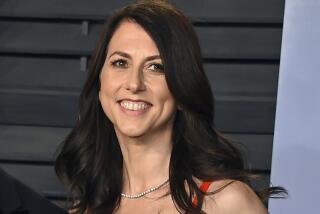Donor-advised funds a bright spot in charitable giving
On a wet Saturday near Griffith Park, a dozen teenage girls shovel manure, trudge through mud and try to stay warm. But soon everyone perks up because another horse-riding lesson is about to begin.
The lessons are provided by Taking the Reins, a nonprofit group that teaches horse care and riding to girls, many from the inner city, with the esteem-building aim of “empowering girls through horse power,” according to the group’s slogan.
“We try to instill confidence and teach teamwork, responsibility, leadership through riding and caring for horses,” said Jane Haven, the program’s executive director. The program also teaches about nutrition and organic gardening.
Taking the Reins gets some of its funding through Vanguard Charitable Endowment, a fast-growing type of philanthropic vehicle called a “donor-advised fund” that serves as a middleman between benefactors and charities.
Such funds are little known by the public but have become stars in philanthropy circles.
Donor-advised funds have seen sharp growth even though charitable giving overall has been largely flat since the recession.
The funds have become popular because they allow people to put their donations in an account (usually starting at $5,000) and claim an immediate tax deduction, even though they might not deliver the contribution to a cause for months or — as some critics complain — years. Foundations are able to meet requirements to donate an average of at least 5% of their assets a year.
Donors don’t have to worry about paperwork from multiple contributions, and they can donate certain kinds of non-cash assets, such as stock and property.
A big draw is that the funds allow contributors to get the maximum tax advantage, particularly for appreciated assets such as stock that is worth more than when it was purchased a year or more earlier. Putting the assets in a donor-advised fund would avoid the capital gains taxes they pay if appreciated assets are sold and the cash is directly donated to a charity.
Some funds are run by the charitable arms of some of the nation’s best-known financial firms, such as Fidelity Investments, Vanguard Group and Charles Schwab Corp.
Many donor-advised funds were established in recent decades but have already begun to match the efforts of some of the nation’s most established charities, said Stacy Palmer, editor of the Chronicle of Philanthropy. Fidelity’s 22-year-old fund, for instance, is vying for the title of the nation’s largest charitable fundraiser with United Way Worldwide, which traces its roots to 1887.
“Fidelity Charitable hasn’t been around very long,” said Palmer, whose publication annually tracks the nation’s 400 most successful fundraising charities, foundations, universities and funds. “The fact that it is now rivaling the United Way, the name most people think of when they think of charities, is pretty incredible.”
In 2012, United Way raised more than $3.9 billion, up just 0.6% from 2011 efforts.
Fidelity Charitable, the largest donor-advised fund, pulled in $3.3 billion in 2012, up 89.1% over the previous year, putting it ahead of the Salvation Army for the first time.
Kim Laughton, president of Schwab Charitable, said that donor-advised funds allow time for more informed and nuanced giving.
“They are not having to rush into a decision,” Laughton said. “That is really helpful to people who want to give when they are ready.”
Moira Carroll, 47, of Santa Fe, N.M., took over the Christopher Thomas Carroll Memorial Fund in 2008 after the death of her father, Thomas, that year. The fund, established in 2002 in the name of her brother, who died from small cell lung cancer, has been run through Fidelity Charitable since its inception.
“I’m really glad my father chose Fidelity because it is really easy,” Carroll said. “The professional management, the investment choices, the ease of giving the grants. It’s all seamless.”
Carroll says her family has used the fund to donate $100,000 a year to the V Foundation for Cancer Research.
Critics of donor-assisted funds worry that their rapid growth is harming other charities.
The biggest concern is that the donations going into these funds are too often parked for long periods instead of going immediately to charities, said Ray D. Madoff, a professor at the Boston College Law School and an expert on estate issues.
Madoff said a regulatory fix is necessary: give donor-advised funds a mandatory time limit to distribute funds to charity.
“There’s a simple solution,” Madoff said. “Subject them to a payout requirement. A 10-year period. At the end of 10 years, the money goes to a charity you named ... that would give people flexibility.”
United Way Worldwide sees the funds more as allies than adversaries, said Sherrie Brach, the group’s executive vice president of investor relations.
“We are not competitors,” Brach said. “The United Way is also a recipient of charitable dollars from donor-advised funds.”
For the equestrian empowerment provided by Taking the Reins, Vanguard provides a crucial function by funneling money from the LA84 Foundation, which uses profits from the 1984 Summer Olympics to support youth sports programs.
To maintain its tax status as a public charity, Taking the Reins must receive a substantial portion of its funding from public sources, not from private foundations like LA84. Donor-assisted funds also are categorized as public charities, which allows Vanguard to serve as a conduit for LA84’s donation to the charity.
“Without these funds, some groups would not be able to give us as much funding as they do now, and that’s important to us,” said Haven of Taking the Reins, which serves about 200 to 225 girls a year ages 11 to 18.
Although LA84 makes many direct donations to nonprofits, using Vanguard Charitable Endowment gives the foundation more flexibility, said attorney Anita L. DeFrantz, LA84 Foundation’s board president and a member of the 1976 and 1980 U.S. Olympic teams.
“We are able to donate more without worrying,” DeFrantz said. “And that’s really our goal.”
Twitter: @RonDWhite







